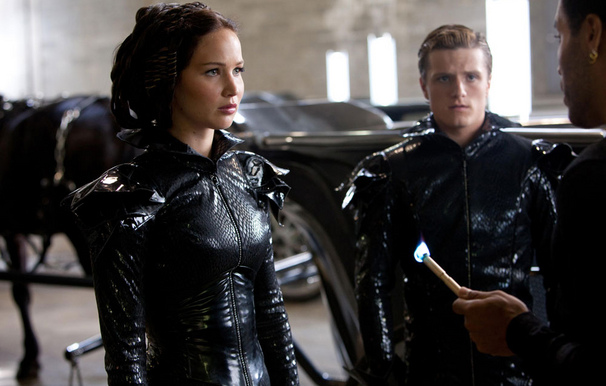How to Make the Girl on Fire in 'Hunger Games' a Reality

This article contains mild plot and fashion spoilers for "The Hunger Games" books and movie(s).
When "Hunger Games" heroine Katniss Everdeen appears before a cheering crowd in a cape and headdress wreathed by flames, she earns the lasting nickname of the "girl on fire." But any ordinary person hoping to achieve such a fiery fashion statement without risking burns will have to wait for today's clothing to catch up with tomorrow's technologies.
The Hollywood filmmakers who adapted "The Hunger Games" — the story of a dystopian North American society where teenage "tributes" must fight to the death in a televised reality show — chose to depict the extreme wardrobe choice with computer-generated special effects. That's because no existing technologies can recreate the story's "synthetic fire" that poses no threat to Katniss besides a faint "tickling" sensation.
"If you're doing actual flames on a body, it'd have to be a stunt person unless you train somebody," said Peter Kunz, a Hollywood special effects expert based in High Falls, N.Y.
Kunz has used stunts, dummies and Hollywood mirror tricks to create film spectacles such as a person's hair on fire or a nude human body in flames. But scenes that mix stunt experts with real fire can last only about 30 seconds to a minute without extreme danger, Kunz said.
Real fire stunts (not for the untrained) require special fuel mixtures, protective clothing and careful coordination with stunt people so that they don't suffer serious injury. By contrast, a surprised Katniss only realizes her costume's effect for the first time when her stylist lights it on fire.
The burning costumes worn by Katniss and fellow tribute Peeta Mellark are meant to symbolize the coal mining in their home of District 12 — a place located somewhere in the former U.S. Appalachia region. That contributes to their dazzling "Hunger Games" debut in the Capitol of the dystopian society Panem.
Get the world’s most fascinating discoveries delivered straight to your inbox.
"We're not far enough into the future to do it," Kunz told InnovationNewsDaily. "The only other way that I can see it since you said a live audience, you see flames made out of silk. You could do that with the right lighting and clothing, and some augmentation [in film post-production]."
A combination of colored silk and lighting has often been used in theater plays, Kunz explained. That may represent the most reasonable choice for any "Hunger Game" fans who want to walk in Katniss' shoes for a day.
Katniss and Peeta only have to deal with the synthetic fire costumes once, but the fire theme recurs throughout the "Hunger Game" series in the fashion choices made by their stylists. Some of their later costumes have fabric capable of lighting up — an effect that some DIY fashion geeks can already achieve by combining LED lights and batteries with clothing.
Making such costumes could prove easier as scientists work on "smart textiles" and "smart clothing" that uses special fibers to replace the bulky electronics of today's gadgets. But for now, anyone wishing to enjoy the full glory of "the girl on fire" would do best settling for some Hollywood magic on the big screen.
This story was provided by InnovationNewsDaily, sister site to LiveScience. You can follow InnovationNewsDaily Senior Writer Jeremy Hsu on Twitter @ScienceHsu. Follow InnovationNewsDaily on Twitter @News_Innovation, or on Facebook.





